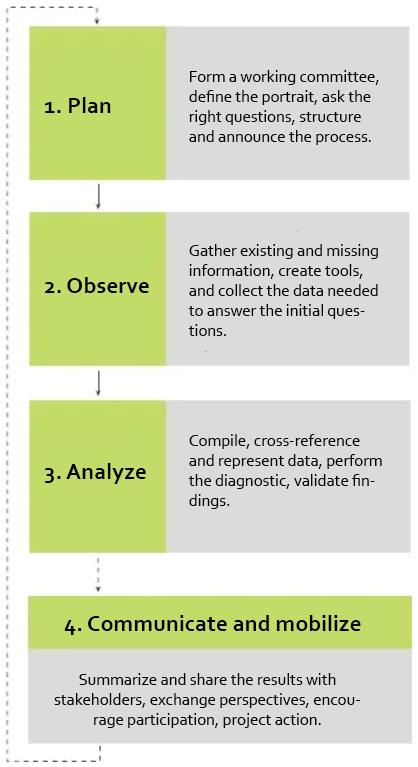Carrying out a food access diagnosis
A diagnostic portrait of food access is an examination of a given territory’s characteristics in relation to food.1 For example, depending on local needs, the partners could take a snapshot of the situation (T0) in terms of food access: number of food outlets by type in the territory, their physical access, the quality of the food supply, etc. As a complement, they could also examine the quality of the population's dietary intake and food insecurity level. This diagnosis can serve as a basis for identifying priority actions for the region and can be used to reassess the situation once solutions have been implemented.
It is an excellent way to mobilize partners and find collective solutions to a need or problem. The results of the portrait can also be useful to confirm impressions, support decision-making and take action, collect initial data that will be useful for tracking the evolution of an issue and secure funding.1
How to create a diagnostic portrait
Vivre en ville proposes four steps for creating a diagnostic portrait. For further details, see the document: Nourrir tous les milieux : trousse d’accompagnement pour la réalisation d’un portrait-diagnostic de l’accès à une saine alimentation.

Translated from: Vivre en ville 2022
Tools used in the EffICAS study
These tools, drawn from the work of a number of researchers and public health organizations, enhance the current range of tools available for assessing the food accessibility situation offered by Vivre en ville in its support kit. Depending on assessment needs, the proposed tools can be used separately, together or in combination with other tools.
The EffICAS food desert identification tool is available online, while the other tools take the form of questions to be included in a questionnaire.
Identify food deserts and territories with poor geographic food access to stores offering nutritious food.
Examine citizens’ perceptions of their food environment.
Determine the number of food-insecure households in a given territory.
Measure fruit and vegetable consumption and the overall diet quality of the citizens.
Measure elements of vitality and perception of life in the community.
For more information
- Consult the Vivre en ville website and their publication Villes nourricières, Mettre l’alimentation au cœur des collectivités to learn more about the steps involved in establishing a community food initiative.
- Consult the Guide pour l’élaboration d’un plan de développement d’une communauté nourricière published by the Ministère de l’Agriculture, des Pêcheries et de l’Alimentation du Québec.
Evaluating the process of establishing a food co-op
- Vivre en ville. (2022). Nourrir tous les milieux : Trousse d’accompagnement pour la réalisation d’un portrait-diagnostic de l’accès à une saine alimentation. https://carrefour.vivreenville.org/publication/nourrir-tous-les-milieux

